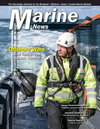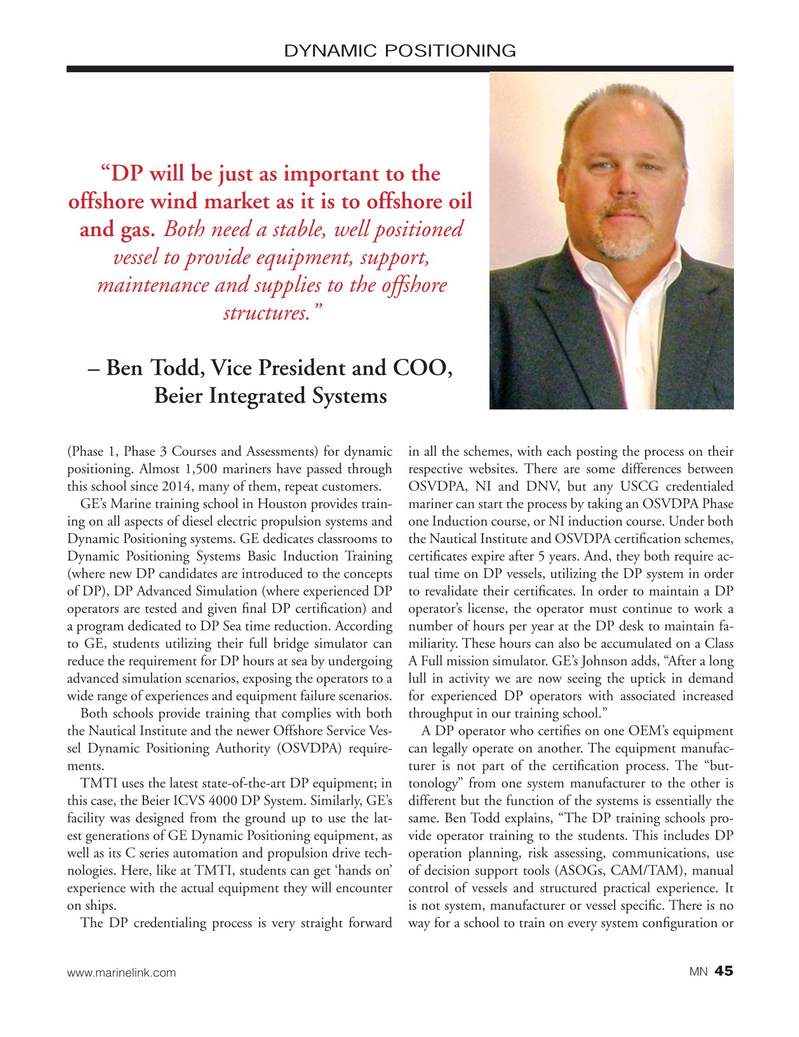
Page 45: of Marine News Magazine (September 2019)
Vessel Conversion and Repair
Read this page in Pdf, Flash or Html5 edition of September 2019 Marine News Magazine
DYNAMIC POSITIONING “DP will be just as important to the offshore wind market as it is to offshore oil and gas. Both need a stable, well positioned vessel to provide equipment, support, maintenance and supplies to the offshore structures.” – Ben Todd, Vice President and COO,
Beier Integrated Systems (Phase 1, Phase 3 Courses and Assessments) for dynamic in all the schemes, with each posting the process on their positioning. Almost 1,500 mariners have passed through respective websites. There are some differences between this school since 2014, many of them, repeat customers. OSVDPA, NI and DNV, but any USCG credentialed
GE’s Marine training school in Houston provides train- mariner can start the process by taking an OSVDPA Phase ing on all aspects of diesel electric propulsion systems and one Induction course, or NI induction course. Under both
Dynamic Positioning systems. GE dedicates classrooms to the Nautical Institute and OSVDPA certi? cation schemes,
Dynamic Positioning Systems Basic Induction Training certi? cates expire after 5 years. And, they both require ac- (where new DP candidates are introduced to the concepts tual time on DP vessels, utilizing the DP system in order of DP), DP Advanced Simulation (where experienced DP to revalidate their certi? cates. In order to maintain a DP operators are tested and given ? nal DP certi? cation) and operator’s license, the operator must continue to work a a program dedicated to DP Sea time reduction. According number of hours per year at the DP desk to maintain fa- to GE, students utilizing their full bridge simulator can miliarity. These hours can also be accumulated on a Class reduce the requirement for DP hours at sea by undergoing A Full mission simulator. GE’s Johnson adds, “After a long advanced simulation scenarios, exposing the operators to a lull in activity we are now seeing the uptick in demand wide range of experiences and equipment failure scenarios. for experienced DP operators with associated increased
Both schools provide training that complies with both throughput in our training school.” the Nautical Institute and the newer Offshore Service Ves- A DP operator who certi? es on one OEM’s equipment sel Dynamic Positioning Authority (OSVDPA) require- can legally operate on another. The equipment manufac- ments. turer is not part of the certi? cation process. The “but-
TMTI uses the latest state-of-the-art DP equipment; in tonology” from one system manufacturer to the other is this case, the Beier ICVS 4000 DP System. Similarly, GE’s different but the function of the systems is essentially the facility was designed from the ground up to use the lat- same. Ben Todd explains, “The DP training schools pro- est generations of GE Dynamic Positioning equipment, as vide operator training to the students. This includes DP well as its C series automation and propulsion drive tech- operation planning, risk assessing, communications, use nologies. Here, like at TMTI, students can get ‘hands on’ of decision support tools (ASOGs, CAM/TAM), manual experience with the actual equipment they will encounter control of vessels and structured practical experience. It on ships. is not system, manufacturer or vessel speci? c. There is no
The DP credentialing process is very straight forward way for a school to train on every system con? guration or 45 www.marinelink.com MN
MN Sept19 Layout 32-49.indd 45 8/27/2019 12:32:52 PM

 44
44

 46
46
